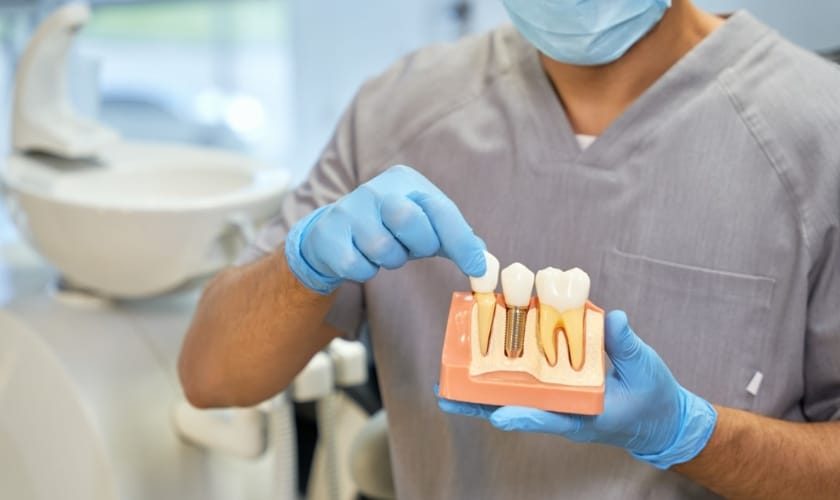Pay Online
What To Expect When Getting Dental Implants: A Comprehensive Guide

Our comprehensive guide on dental implants! If you’re considering this transformative procedure, you’ve come to the right place. Dental implants are a fantastic solution for those seeking a permanent and natural-looking replacement for missing teeth. Whether you have lost teeth due to decay, injury, or other reasons, dental implants can help restore your smile and improve your overall oral health. This article will discuss the different types of dental implants available and their advantages over other tooth replacement options, walk you through the step-by-step procedure involved in getting dental implants, and provide essential information on recovery and aftercare. So, let’s dive in and discover everything you need to know about getting dental implants!
The Different Types of Dental Implants
When it comes to dental implants, there are several types available to suit different needs and situations.
Endosteal Implant: The most common type is the endosteal implant, which involves placing a titanium screw directly into the jawbone. This serves as the foundation for attaching an artificial tooth or crown. Endosteal implants are highly durable and can last a lifetime with proper care.
Subperiosteal Implant: Another type of dental implant is the subperiosteal implant, which is placed on top of the jawbone but below the gum line. This option is ideal for patients with insufficient bone height or density to support traditional implants. Subperiosteal implants offer stability and functionality while providing a solution for those with limited bone structure.
Implant-Supported Denture: An implant-supported denture may be recommended for individuals missing multiple teeth or even entire arches. These dentures attach securely to dental implants to provide maximum stability and prevent slippage during eating or speaking.
All-On-4 Dental Implants: All-on-4 dental implants are another popular choice for replacing full arches of teeth. With this method, only four strategically placed implants support a complete set of upper or lower teeth, eliminating the need for individual screws for each tooth.
Regardless of which type you choose, you must consult with your dentist to determine which option will best meet your specific needs and goals. Before recommending the most suitable treatment plan, they will assess factors such as bone density, overall oral health, and aesthetic considerations.
The Advantages of Dental Implants
When it comes to replacing missing teeth, dental implants offer a range of advantages that make them an excellent choice. First and foremost, dental implants are designed to look and feel like natural teeth. This means you can smile confidently without worrying about anyone noticing your implants.
Another advantage is the durability of dental implants. Unlike other tooth replacement options, such as dentures or bridges, which may need to be replaced every few years, dental implants can last a lifetime with proper care.
One of the biggest benefits of dental implants is their ability to preserve jawbone health. When a tooth is lost, the surrounding bone can deteriorate over time. However, dental implants stimulate bone growth and help maintain your facial structure.
Furthermore, unlike dentures that can slip or cause discomfort while eating or speaking, dental implants are securely anchored in your jawbone so you can enjoy all your favorite foods and speak naturally without any hindrance.
Additionally, dental implant surgery has a high success rate and is generally well-tolerated by patients. The procedure may require some recovery time, but the long-term benefits outweigh this temporary inconvenience.
The Procedure: Step-by-Step Guide
If you’re considering getting dental implants, it’s important to understand the step-by-step process involved. While every case is unique, here is a general guide to what to expect during your dental implant procedure.
1. Consultation and Treatment Plan: Before starting the procedure, your dentist will thoroughly examine your mouth and jawbone. This will help determine if you are a suitable candidate for dental implants. They will also create a personalized treatment plan based on your specific needs.
2. Preparation: During the preparation phase, any necessary extractions or bone grafting may be performed to ensure optimal implant placement. These procedures help strengthen the jawbone and provide a solid implant foundation.
3. Implant Placement: Once your jawbone has healed and is ready for implant placement, the titanium posts will be surgically inserted into your jawbone. This serves as an artificial tooth root that provides stability and support for the replacement teeth.
4. Osseointegration: After implant placement, osseointegration occurs over several months as the surrounding bone fuses with the titanium posts. This process ensures a strong and durable bond between the implants and jawbone.
5. Abutment Placement: Once osseointegration is complete, abutments are attached to the implanted posts using small connectors called healing caps or temporary crowns. The abutments act as anchors for attaching custom-made prosthetic teeth or bridges.
6. Restoration: Once everything has healed properly, impressions of your mouth are taken to create natural-looking replacement teeth that match perfectly with your existing smile.
Remember that each patient’s journey may vary slightly depending on individual circumstances and requirements outlined in their treatment plan! Always consult an experienced dentist who can guide you through this transformative process with care!
Intrigued? Keep reading our blog series about dental implants, where we’ll cover recovery and aftercare to ensure a successful outcome!
Source: Gebrüder Betz Medical Animation
Recovery and Aftercare
Recovery and aftercare are crucial aspects of the dental implant process. After the procedure, taking certain steps is important to ensure a smooth healing process.
Immediately following the surgery, you may experience some discomfort and swelling. This is completely normal and can be managed with over-the-counter pain medications prescribed by your dentist. Applying an ice pack to the affected area can also help reduce swelling.
For proper healing to occur, following your dentist’s instructions regarding diet and oral hygiene is essential. You’ll likely be advised to stick to soft or liquid foods for a few days while avoiding hot or spicy items that could irritate the surgical site.
Maintaining good oral hygiene is crucial during this time as well. Your dentist will provide specific instructions on caring for your implants, including brushing techniques and any additional products you may need.
It’s common to experience some minor bleeding in the days following surgery. However, if bleeding persists or becomes excessive, contact your dentist immediately.
Attend all scheduled follow-up appointments with your dentist so they can monitor your progress and address any concerns that may arise.
By closely adhering to these aftercare guidelines, you’ll give yourself the best chance at successful healing and long-term implant success!
Dental implants offer a fantastic solution for those seeking to restore their smile and improve their oral health. With different types of implants, you can find the perfect option that suits your needs.
Remember that every patient is unique, so consult an experienced dentist specializing in dental implant procedures to determine if this treatment is right for you.
Are you ready to transform your smile? Book a consultation with a trusted dentist today to explore how dental implants can enhance your appearance and quality of life!
Recent Posts

Swelling, Fever, or Abscess? How to Spot a Dental Emergency Early

Unlock Your Annual Maximum: The Hidden Financial Benefit of Your Dental Insurance’s “Use-It-or-Lose-It” Policy

Bad Breath in Children: Common Causes and Solutions from a Dentist in Elgin

Northeast Family Dental Care Elgin Explains Best Habits to Prevent Tooth Grinding


